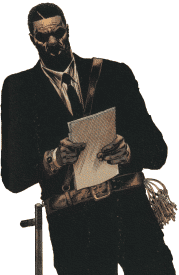Iron Heights (original) (raw)
Three miles outside Keystone City lies Iron Heights, a maximum-security prison capable of holding metahuman prisoners. Under its most well-known warden, Gregory Wolfe, only one prisoner had ever escaped until recently: the Pied Piper (who subsequently abandoned crime for social activism).
After the Piper’s escape, Iron Heights underwent a massive restructuring to prevent another breakout. Wolfe’s control over the prison tightened even further, and the super-powered criminals were moved underground to an area called “the Pipeline.” The Pipeline itself resembles a dungeon more than a modern prison. The most dangerous metahuman prisoners are put in their costumes for easy identification, placed in a cell, and basically forgotten. Guards—and mainenance personnel—avoid it whenever possible.
Any “mask” spotted outside the Pipeline is shot on sight.
Perhaps the worst example of the inhumanity dealt out in Iron Heights is the case of Fallout, a man who became radioactive in an accident and turned himself in after his condition killed his family. He was stricken from the records and placed in the generator room, where he powered the prison for years.
Lower-level metahuman prisoners are housed in E-Block, a more high-tech wing of the prison. Inmates wear standard prison jumpsuits and collars that dampen their powers and dispense electric shocks.
Breakouts
While investigating an outbreak of anthrax at the prison (see Murmur), Flash Wally West learned of the conditions inside. (Flash: Iron Heights, 2001) He found himself at odds with Wolfe several times over those conditions, but Wolfe had two advantages: he’s a close friend of the governor, and (more importantly) he gets results. One thing the Flash did manage to do was replace the power systems so that Fallout isn’t in constant pain. (Flash v.2 #181, 2002)
After Murmur’s escape, more and more villains began finding ways out. Most spectacularly, a riot occurred when Grodd summoned an army of apes to retrieve him. (Flash v.2 #192–193, 2003) The most powerful rogues escaped in the confusion, and the Flash has been hard at work putting them back.
Disaster
Sometime during the year following Infinite Crisis, the Outsiders attempted to break the hero Black Lightning out of Iron Heights.* The rescue was a disaster. Power shorted out, leaving E-Block’s dampeners inactive. Wolfe himself stepped in to shut down the subsequent riot using his ability to constrict muscles. The Outsiders’ Shift attempted to counter him by filling the room with a gaseous muscle relaxant, but Wolfe simply pushed back harder. He overextended his power, killing over forty prisoners and guards and nearly himself.
Despite his role in the fiasco, Wolfe remains in charge of the prison.
Text by Kelson Vibber. Do not copy without permission.
 Art
Art
- Flash: Iron Heights (2001) - Ethan van Sciver and Prentis Rollins
Profiles
- Flash Secret Files #3 (November 2001)
Legacy-Era Significant Appearances
- Flash: Iron Heights (2001), Geoff Johns
- Flash #179 (December 2001): “Smile for the Camera,” Geoff Johns
- Flash #180 (January 2002): “Peek-a-Boo,” Geoff Johns
- Flash #181 (February 2002): “Fallout,” Geoff Johns
- DC First: Flash/Superman (July 2002): “Speeding Bullets,” Geoff Johns
- Flash #189 (October 2002): “Messengers,” Geoff Johns
- Flash #191 (December 2002): “The Brave and the Beaten,” Geoff Johns
- Flash #192–193 (January–February 2003): “Run Riot” Parts 1–2, Geoff Johns
- Flash #200 (September 2003): “Blitz Conclusion: The Final Race,” Geoff Johns
- Flash #207–208 (April–May 2004): “Rush Hour” and “The Red Carpet,” Geoff Johns
- Flash #210–211 (July–August 2004): “Reconnected” and “Animal House,” Geoff Johns
- Flash #213 (October 2004): “Slow Motion,” Geoff Johns
- Flash #219 (April 2005): “Truth or Dare, Part 1” Geoff Johns
- Gotham Central #29–30 (May–June 2005): “Keystone Kops, Parts 2–3,” Greg Rucka
- Flash #½ (2005): “Rogue Wars Prologue: Tricksters,” Geoff Johns
- Flash #227 (December 2005): “Finish Line, Part 1: The Last Days,” Joey Cavalieri (dream sequence)
Significant One-Year-Later Appearances
- Final Crisis: Rogues’ Revenge #1 (September 2008), Geoff Johns
Notes
* The timeline is unclear. The initial One Year Later issues of Outsiders suggest they have been off the radar for most of the year, but 52 suggests that it is 8 months in. Nightwing is out of the country for the first 7 months (52 #30, 2006), and Captain Boomerang, Jr.—in Iron Heights at the time of the disaster—goes on a mission for the Suicide Squad 8 months in (52 #33–34, 2006).
As for why Black Lightning was in prison: He believed he had killed a man, and wanted to pay for his crimes. The organization Checkmate set up a fake identity and prosecution, and had him incarcerated under the alias Derek Cooper. The Outsiders later learned that the victim had actually been killed by a poison dart just before the hero hit him. They also learned that his cover was blown, and a contract was out on his life.
